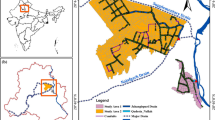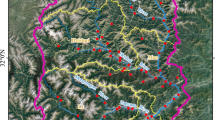Abstract
Flooding can occur naturally due to heavy rain, exceptionally high tides, snowmelt, or human-made causes such as dam break, breach of river embankment, and so on. Urban flooding and its associated fury have become very common in the recent past. The combined effects of urbanization and climate change have increased the risk of flooding in cities that can be attributed to various factors. The urbanization causes imperviousness of the surface due to more built-up areas, which lead to reduced infiltration, thus, an increment in the surface runoff. Climate change has affected the quantity, intensity, and frequency of precipitation, which made the urban catchments more vulnerable to flooding. The present study aims to investigate the potential impacts of climate change on the surface runoff characteristics of an urbanized watershed. The future climate scenario corresponding to the study area was obtained from global climate models (GCM) that has shown superior performance in forecasting the future climate. As the GCM outputs are for a larger grid, they must be downscaled to the local/regional scale to obtain the corresponding climatic variables. In this study, we have used the delta change method of downscaling. Further, the runoff was simulated using the stormwater management model (SWMM), considering the future scenario. The results from precipitation analysis indicate an increase in precipitation in the future. Consequently, the simulated runoff has shown an increment in the number of flood events in 2025, 2050, 2075, and 2100. The present study has also found that the continuous rainfall simulation was resulting in an underestimation of the urban runoff. Therefore, for urban applications, event-based runoff simulation would be a better choice for characterizing the future urban flood events.
Access this chapter
Tax calculation will be finalised at checkout
Purchases are for personal use only
Similar content being viewed by others
References
Anandhi A, Frei A, Pierson DC, Schneiderman EM, Zion MS, Lounsbury D, Matonse AH (2011) Examination of change factor methodologies for climate change impact assessment. Water Resour Res 47(3)
Ebrahimian A, Gulliver JS, Wilson BN (2016) Effective impervious area for runoff in urban watersheds. Hydrol Process 30(20):3717–3729
Ghosh S, Mujumdar PP (2008) Statistical downscaling of GCM simulations to streamflow using relevance vector machine. Adv Water Resour 31(1):132–146
Han WS, Burian SJ (2009) Determining effective impervious area for urban hydrologic modeling. J Hydrol Eng 14(2):111–120
Nicholls R, Hoozemans F, Marchand M (1999) Increasing flood risk and wetland losses due to global sea-level rise: regional and global analyses. Global Environ Change 9(SUPPL.):S69–S87
Patil A (2015) Urban hydrology, need of India. Environ We Int J Sci Technol 10:29–36
Perumal M, Sahoo B (2010) Real-time flood forecasting by a hydrometric data-based technique. Natural and Anthropogenic Disasters: Vulnerability, Preparedness, and Mitigation
Rao KHVD, Rao VV, Dadhwal VK, Behera G, Sharma JR (2011) A distributed model for real-time flood forecasting in the Godavari Basin using space inputs. Int J Disaster Risk Sci 2(3):31–40
Ravagnani F, Pellegrinelli A, Franchini M (2009) Estimation of urban impervious fraction from satellite images and its impact on peak discharge entering a storm sewer system. Water Resour Manage 23(10):1893–1915
Rossman LA (2010) Storm water management model user’s manual. Version
Sahoo SN, Sreeja P (2014) A methodology for determining runoff based on imperviousness in an ungauged peri-urban catchment. Urban Water J 11(1):42–54
Sahoo SN, Sreeja P (2016) Determination of effective impervious area for an urban Indian catchment. J Hydrol Eng Am Soc Civil Eng 21(4):5016004
Tabari H, De Troch R, Giot O, Hamdi R, Termonia P, Saeed S, Brisson E, Van Lipzig N, Willems P (2016) Local impact analysis of climate change on precipitation extremes: are high-resolution climate models needed for realistic simulations? Hydrol Earth Syst Sci 20(9):3843–3857
Willems P, Vrac M (2011) Statistical precipitation downscaling for small-scale hydrological impact investigations of climate change. J Hydrol 402(3–4):193–205
Zahmatkesh Z, Burian SJ, Karamouz M, Tavakol-Davani H, Goharian E (2015) Low-impact development practices to mitigate climate change effects on urban stormwater runoff: case study of New York City. J Irrig Drain Eng 141(1):04014043
Author information
Authors and Affiliations
Corresponding author
Editor information
Editors and Affiliations
Rights and permissions
Copyright information
© 2023 The Author(s), under exclusive license to Springer Nature Singapore Pte Ltd.
About this paper
Cite this paper
Suresh, A., Pekkat, S. (2023). Climate Change and Its Impact on Surface Runoff Characteristics of an Urban Catchment. In: Bhattacharjya, R.K., Talukdar, B., Katsifarakis, K.L. (eds) Sustainable Water Resources Management. Advances in Sustainability Science and Technology. Springer, Singapore. https://doi.org/10.1007/978-981-16-7535-5_1
Download citation
DOI: https://doi.org/10.1007/978-981-16-7535-5_1
Published:
Publisher Name: Springer, Singapore
Print ISBN: 978-981-16-7534-8
Online ISBN: 978-981-16-7535-5
eBook Packages: EngineeringEngineering (R0)




